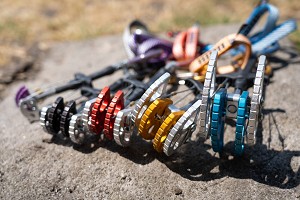
Metolius are no new comers to cams, and in a market which is about as saturated as you can get from cheap and cheerful cams from Eastern Europe to technical micro cams from BD and CHH with intricacies that boggle the mind, you have to pull something really special out of the bag to keep afloat.
Competitive markets breed competitive companies, so cam manufacturers tend to have a specific trait for each one of their cams, whether that be concentrating on weight, camming range or price. In a bid to distinguish themselves from one another so that they aren't all offering the same product, your average climber now has a huge array of cams to chose from meaning that instead of just being faced with with a 'all round' cam he can now specialise his selection to best fir his needs.
In almost complete contrast to the main cam manufacturer in the world, Black Diamond, Metolius have gone for the light weight and higher holding power factor in their cams. The Power Cam is one of their latest offerings in their line up of cams that range from the superlight TCU systems to the more bizarre looking Supercams.
It's worth mentioning that so far I have only used these cams over the winter, having received them in December. However the granite of Chamonix provides great cam placements all winter long and as far as usability and durability are concerned an alpine winter is a far better testing ground than cragging in the sun.
About the Cam
As mentioned before Metolius have decided to specialise in weight and holding power. Holding power and camming range are directly related so that to increase one you have to sacrifice the other. The real mathematical and complicated design part of a cam is in the lobes. As with everything in life there is a trade off. The greater the cam angle the greater the camming range but the lesser the holding power of the cam. The best way I can think of to desceribe this is if you interweave your fingers together and mimic your hands as the cam lobes. Obviously the more compact you make the shape the better it is going to hold, whilst if you pull your palms further away from each other and flatten out your hands a little you will see that the camming range is obviously going to be greater but the holding strength is going to be less.
“Regardless of size, brand, number of stems or axles, all camming devices have one thing in common, they are all based on a special curve called a logarithmic spiral. A logarithmic spiral is special because it changes its size with a particular geometric relationship. This relationship defines the angle at which the cams come in contact with the surrounding rock. The smaller this angle, the more the cam clutches the surrounding rock, but at a cost of decreased range and increased forces on both the rock and the camming device components. The larger this angle the better the range but the more the unit must rely on friction in order to hold. Logarithmic spirals are important because they ensure that the cam angle is constant throughout the entire range of the camming device, otherwise the holding power would depend on how much it was retracted. Although cam angle varies between brands of camming devices, most climbing equipment companies maintain one cam angle throughout their entire line."
"In the sixties these spirals started to be incorporated into passive climbing anchors. In the mid-seventies four individual cams were assembled onto one rigid stem creating the first Spring Loaded Camming Device (SLCD). About a decade later Tony Christianson devised a way to maximize range without compromising holding power and the Camalot was born."- Paul Tusting, Quality Assurance Engineer BD
If everyone used the same cam angle then all cams would have the same camming ranges. Its really just a case of where do you draw the line between holding power vs camming range that differs between the manufacturers. Of course you can then start to get very involved with the lobe shape themselves. You will have no doubt notice that the lobes are not a perfect quarter circle curve but that they differ ever so slightly in their curve compared to other manufacturers- this is particularly noticeable on the larger cams. Of course in an ideal world you want to maximise both the holding power and the camming range and it is now down to the cam lobe curvature and design to best serve those purposes.
So as you can see there is a trade off. Black Diamond exploited this and coupled it with their dual axle head design to provide the largest camming range of any cam around. Metolius went back to the drawing board though and decided that holding power was a more important factor than range. Neither is right or wrong of course; it mainly comes down to what you prefer. The increase in holding power is massive though with Metolius reporting a 30% increase over competitor cams.

Another development in recent years has been focused on reducing the head width of cams so that they can fit in narrower placements. The Black diamond C3 released in 2004 made huge steps in that department by offering a micro cam with 30% narrower head than any of its competitors. Metolius has also made steps in this area by incorporating what they called Direct Axle Technology, or DAT, into the Power cam units. Essentially it does without the traditional end caps on the head and instead the U stem cable is attached directly through holes in the axle. Whilst the cam head is still pretty wide getting rid of the end caps not only does away with wasted space on the side but also reduces the weight of the unit.
How did it fare
These are the first cams I've used from Metolius. People tend to stick with a brand when it comes to cams and for me it's always been the C4s from Black Diamond. The greater camming angle and amazing build quality means that they never let me down even on miserable winter days out. When I received the Metolius cams my first impression was that they looked cheap and fragile- not exactly what I had in mind for a winter of climbing ahead of me. However looks can be deceiving and in practice they are awesome.
Winter weather has an annoying tendency of rendering cams totally useless. Some of the cheaper cam designs lock up instantly at even the sight of snow and ice. The BD C4s have always been awesome in winter and I wasn't sure how the Power Cams would do but they have yet to lock up on me- I even managed to get over to the Ben for two days of climbing in miserable weather and whilst everything else was getting nailed by snow and wind the springs and lobes on the Power Cams kept working perfectly.
The U-stem design has never been a favourite of mine as manipulating trigger bars with gloves on can be almost impossible, and I want cams to work year round (again not a problem if you just use them in summer). However the trigger designs on the Power Cams are slightly larger so that they can be manipulated easily with gloves- bonus in my books. There are proponents of both single and u-stem design so it boils down to personal preference again as the pluses and minuses of both designs largely cancel each other out.
For me, one of the biggest selling points of the Power Cams is their weight. I get pretty obsessed with weight when alpine climbing and the rack always takes a big hit. Cams have the annoying properties of being incredibly quick to place and clean (great when moving together) but also being really heavy compared to passive pro. Flip side to every coin. In the past I've favoured the C4s as the greater camming range means that you can take less of them up in the hills with you to cover a larger range of cracks. However the Power Cams are so light in comparison that you can actually cover the same amount of camming range in total but also end up with more cams on your rack for the same amount of weight....a no brainer really. (See comparison chart above)
The things that did bother me with the cam were pretty minor. I would have liked to have a longer sling on them that you either double up or extend, however very few cam manufacturers actually incorporate this into their cam designs. The cam unit itself is actually quite short in length compared to your average cam. This has obviously helped it to keep the weight down but it does mean that they are harder to place and extract deep in a placement. They are by no means miniature cams but side by side they are noticeably smaller and if it walks deeper into a crack it can be a nightmare to get out again.
Compared to other cams they do suffer in strength ratings as well. No doubt a product of making them superlight. Personally it doesn't bother me as a strength rating of 10kn is more than enough for me but there is a quick comparison below for those interested.

Conclusion
Otherwise I was really taken by the Power Cams. They have been a welcome addition to my rack this winter and have proven great bits of gear when I finally got my head around the fact that the lack of weight did not mean a lack in build quality. The Range Finder has also been quite useful at times because no matter how many cams you have placed its still nice to place one knowing that the cam lobes are perfectly positioned. They will definitely be staying on my rack for a long time to come and it's just a shame that they don't come in any larger sizes.
Price: £43
Weight: 45 to 150 grams



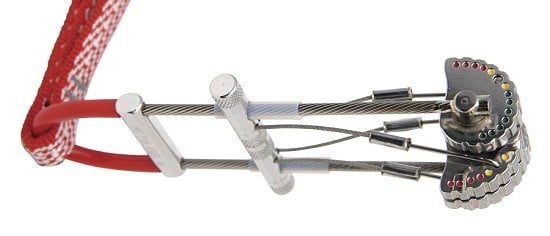

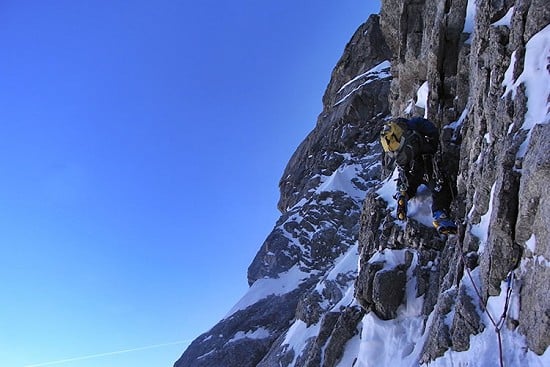

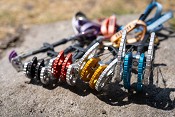
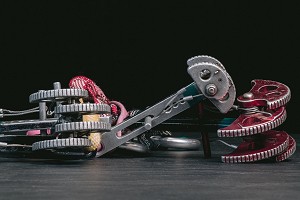

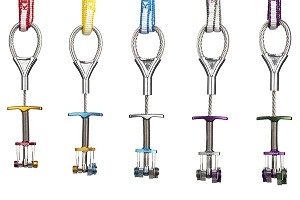
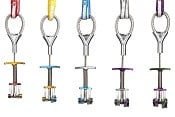
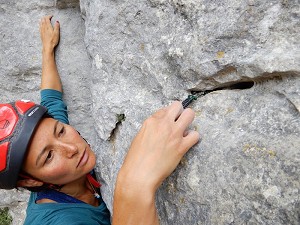
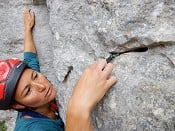
Comments